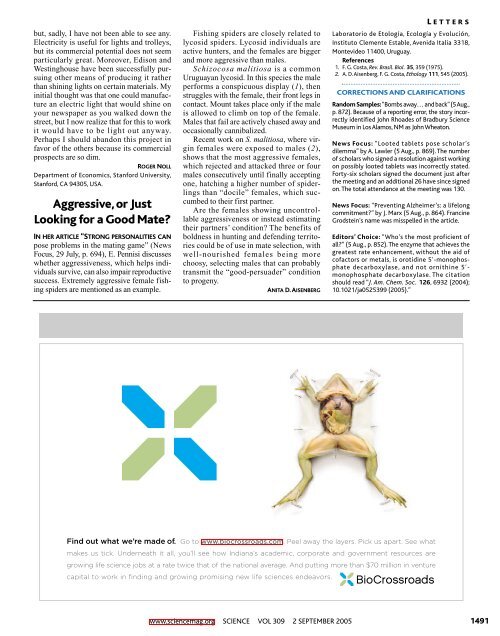THIS WEEK IN
THIS WEEK IN
THIS WEEK IN
Create successful ePaper yourself
Turn your PDF publications into a flip-book with our unique Google optimized e-Paper software.
ut, sadly, I have not been able to see any.<br />
Electricity is useful for lights and trolleys,<br />
but its commercial potential does not seem<br />
particularly great. Moreover, Edison and<br />
Westinghouse have been successfully pursuing<br />
other means of producing it rather<br />
than shining lights on certain materials. My<br />
initial thought was that one could manufacture<br />
an electric light that would shine on<br />
your newspaper as you walked down the<br />
street, but I now realize that for this to work<br />
it would have to be light out anyway.<br />
Perhaps I should abandon this project in<br />
favor of the others because its commercial<br />
prospects are so dim.<br />
ROGER NOLL<br />
Department of Economics, Stanford University,<br />
Stanford, CA 94305, USA.<br />
Aggressive, or Just<br />
Looking for a Good Mate?<br />
<strong>IN</strong> HER ARTICLE “STRONG PERSONALITIES CAN<br />
pose problems in the mating game” (News<br />
Focus, 29 July, p. 694), E. Pennisi discusses<br />
whether aggressiveness, which helps individuals<br />
survive, can also impair reproductive<br />
success. Extremely aggressive female fishing<br />
spiders are mentioned as an example.<br />
Fishing spiders are closely related to<br />
lycosid spiders. Lycosid individuals are<br />
active hunters, and the females are bigger<br />
and more aggressive than males.<br />
Schizocosa malitiosa is a common<br />
Uruguayan lycosid. In this species the male<br />
performs a conspicuous display (1), then<br />
struggles with the female, their front legs in<br />
contact. Mount takes place only if the male<br />
is allowed to climb on top of the female.<br />
Males that fail are actively chased away and<br />
occasionally cannibalized.<br />
Recent work on S. malitiosa, where virgin<br />
females were exposed to males (2),<br />
shows that the most aggressive females,<br />
which rejected and attacked three or four<br />
males consecutively until finally accepting<br />
one, hatching a higher number of spiderlings<br />
than “docile” females, which succumbed<br />
to their first partner.<br />
Are the females showing uncontrollable<br />
aggressiveness or instead estimating<br />
their partners’ condition? The benefits of<br />
boldness in hunting and defending territories<br />
could be of use in mate selection, with<br />
well-nourished females being more<br />
choosy, selecting males that can probably<br />
transmit the “good-persuader” condition<br />
to progeny.<br />
ANITA D. AISENBERG<br />
L ETTERS<br />
Laboratorio de Etología, Ecología y Evolución,<br />
Instituto Clemente Estable, Avenida Italia 3318,<br />
Montevideo 11400, Uruguay.<br />
References<br />
1. F. G. Costa, Rev. Brasil. Biol. 35, 359 (1975).<br />
2. A. D.Aisenberg, F. G. Costa, Ethology 111, 545 (2005).<br />
CORRECTIONS AND CLARIFICATIONS<br />
Random Samples:“Bombs away… and back”(5 Aug.,<br />
p. 872). Because of a reporting error, the story incorrectly<br />
identified John Rhoades of Bradbury Science<br />
Museum in Los Alamos, NM as John Wheaton.<br />
News Focus: “Looted tablets pose scholar’s<br />
dilemma” by A. Lawler (5 Aug., p. 869). The number<br />
of scholars who signed a resolution against working<br />
on possibly looted tablets was incorrectly stated.<br />
Forty-six scholars signed the document just after<br />
the meeting and an additional 26 have since signed<br />
on.The total attendance at the meeting was 130.<br />
News Focus: “Preventing Alzheimer’s: a lifelong<br />
commitment?” by J. Marx (5 Aug., p. 864). Francine<br />
Grodstein’s name was misspelled in the article.<br />
Editors’ Choice: “Who’s the most proficient of<br />
all?” (5 Aug., p. 852). The enzyme that achieves the<br />
greatest rate enhancement, without the aid of<br />
cofactors or metals, is orotidine 5′-monophosphate<br />
decarboxylase, and not ornithine 5′-<br />
monophosphate decarboxylase. The citation<br />
should read “J. Am. Chem. Soc. 126, 6932 (2004);<br />
10.1021/ja0525399 (2005).”<br />
Find out what we’re made of. Go to www.biocrossroads.com. Peel away the layers. Pick us apart. See what<br />
makes us tick. Underneath it all, you’ll see how Indiana’s academic, corporate and government resources are<br />
growing life science jobs at a rate twice that of the national average. And putting more than $70 million in venture<br />
capital to work in finding and growing promising new life sciences endeavors.<br />
www.sciencemag.org SCIENCE VOL 309 2 SEPTEMBER 2005 1491
















